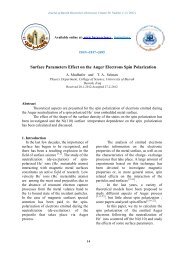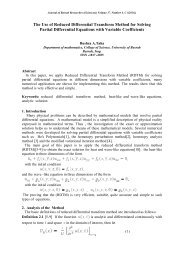Optimum Orientation of Solar Panels in ... - Basra-science-journal.org
Optimum Orientation of Solar Panels in ... - Basra-science-journal.org
Optimum Orientation of Solar Panels in ... - Basra-science-journal.org
You also want an ePaper? Increase the reach of your titles
YUMPU automatically turns print PDFs into web optimized ePapers that Google loves.
various researchers to determ<strong>in</strong>e the optimum<br />
location for solar radiation collection us<strong>in</strong>g<br />
different empirical models. However, solar<br />
radiation varies with geographic latitude, season,<br />
and time <strong>of</strong> a day due to the various sun<br />
positions under the unpredictable weather<br />
conditions. Systematic long-term data<br />
measurements are regarded as the most effective<br />
and accurate method <strong>of</strong> sett<strong>in</strong>g up the solar<br />
radiation database. In many parts <strong>of</strong> the world,<br />
the basic solar data for the surfaces <strong>of</strong> <strong>in</strong>terest<br />
are not always readily obta<strong>in</strong>able. It is also<br />
impracticable to measure the solar radiation for<br />
every tilt angle to deduce the peak value.<br />
Traditionally, solar radiation on an <strong>in</strong>cl<strong>in</strong>ed<br />
surface is model led us<strong>in</strong>g horizontal data.<br />
If modules are not cleaned regularly, it is<br />
recommended that they not be mounted at an<br />
angle flatter than 15”. Flatter angles cannot take<br />
ful1 advantage <strong>of</strong> the clean<strong>in</strong>g action <strong>of</strong> ra<strong>in</strong>fall<br />
[2,3,6,7,8]<br />
To capture the maximum amount <strong>of</strong> solar<br />
radiation over a year, the solar array should be<br />
tilted at an angle approximately equal to a site's<br />
latitude, and fac<strong>in</strong>g with<strong>in</strong> 15° <strong>of</strong> due south. To<br />
optimize w<strong>in</strong>ter performance, the solar array can<br />
be tilted 15° more than the latitude angle, and to<br />
optimize summer performance, 15° less than the<br />
latitude angle. At any given <strong>in</strong>stant, the array<br />
Magnetic decl<strong>in</strong>ation, the angle difference<br />
between magnetic south and true solar south,<br />
must also be taken <strong>in</strong>to account when<br />
determ<strong>in</strong><strong>in</strong>g proper solar array orientation. If a<br />
magnetic compass alone is used to determ<strong>in</strong>e<br />
where to po<strong>in</strong>t the array, you may not capture<br />
<strong>Optimum</strong> <strong>Orientation</strong> <strong>of</strong> <strong>Solar</strong> <strong>Panels</strong> <strong>in</strong> Baghdad …<br />
Fig (3) shows fac<strong>in</strong>g south and sun path [3]<br />
2<br />
will output maximum available power when<br />
po<strong>in</strong>ted directly at the sun<br />
To compare the energy output <strong>of</strong> your<br />
array to the optimum value, you will need to<br />
know the site's latitude, and the actual tilt angle<br />
<strong>of</strong> your array-which may be the slope <strong>of</strong> your<br />
ro<strong>of</strong> if your array is flush-mounted. If your solar<br />
array tilt is with<strong>in</strong> 15° <strong>of</strong> the latitude angle, you<br />
can expect a reduction <strong>of</strong> 5% or less <strong>in</strong> your<br />
system's annual energy production. If your solar<br />
array tilt is greater than 15° <strong>of</strong>f the latitude<br />
angle, the reduction <strong>in</strong> your system's annual<br />
energy production may fall by as much as 15%<br />
from its peak available value. Dur<strong>in</strong>g w<strong>in</strong>ter<br />
months at higher latitudes, the reduction will be<br />
greater.<br />
If a south-fac<strong>in</strong>g ro<strong>of</strong> is unavailable, or<br />
the total solar array is larger than the area <strong>of</strong> a<br />
south-fac<strong>in</strong>g ro<strong>of</strong> section, an east or west-fac<strong>in</strong>g<br />
surface is the next best option figure (3). Be<br />
aware that solar power output decreases<br />
proportionally with a horizontal angle, or<br />
"azimuth," greater than 15° from due south. The<br />
decrease <strong>in</strong> annual power output from a latitudetilted<br />
east or west-fac<strong>in</strong>g array may be as much<br />
as 15% or more <strong>in</strong> the lower latitudes or as<br />
much as 25% or more <strong>in</strong> the higher latitudes <strong>of</strong><br />
the United States. Avoid direct<strong>in</strong>g your tilted<br />
solar panels northwest, north or northeast, as<br />
you'll get little power output.<br />
the maximum amount <strong>of</strong> solar radiation<br />
[3,6,8,9].<br />
The momentary output <strong>of</strong> your system depends<br />
on the angle <strong>of</strong> the sun and the clearness <strong>of</strong> the<br />
sky as well as the temperature and the<br />
cleanl<strong>in</strong>ess <strong>of</strong> the solar module glass. An








